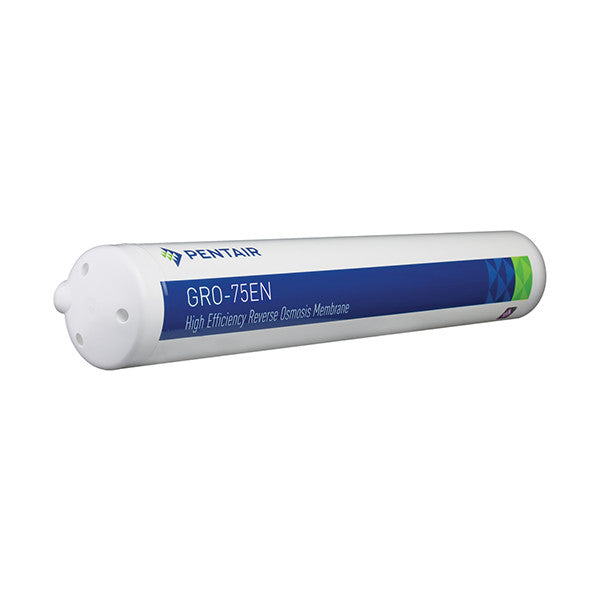
Before getting started, if you don’t know how Reverse Osmosis Drinking water systems work, you can check out my overview video on RO systems first here.
COMPARING BEST-SELLING RO SYSTEMS
Basically, there are two types of Reverse Osmosis drinking water systems when it comes to their filters. Proprietary and non-proprietary. Let’s use these two very popular RO systems as an example: the Water Saver 75 and the Goldline 50.
If your RO system has similar looking filter housings to the Water Saver 75 and this Goldline 50, you’re in luck. That means you have a Reverse Osmosis system that uses non-proprietary filters.
In fact, these systems both use the same most common sediment and carbon filters. Also, each one uses one of the most common post (or after) carbon filter types.
RO REPLACEMENT FILTERS

GOLDLINE 50: The replacement set for the Goldline 50 uses one sediment and two carbon filters with the inline post filter with ¼” threaded fittings at either end. You just unscrew the fittings from the old filter and use them on the new filter.
Get your Goldline replacement filters combo pack here!

WATER SAVER 75: For the Water Saver 75, it also uses the same 3 filters on the bottom but a different carbon filter on top, with this filter replacement bundle. This post carbon filter uses quick connect fittings, which in this case are ¼” but in some cases can be 3/8” or more.
Get your Water Saver 75 replacement filters combo pack here!
PRO TIP: To determine the size needed, just measure the outside diameter of the tubing.
INLINE FILTERS & FITTINGS

To determine which inline filter your system uses, check to see if it has fittings on the ends that can be removed. If so, measure the diameter of the tubing going into the filter and then disconnect the tubing. This YouTube video of mine shows you how.
Wondering how to find out what size fitting you have going into the post filter? Measure the diameter. NOTE: the measurement will not be the same as the “size”. See the following:
- 1/8” fitting is .405 inches or about 3/8” outside diameter
- ¼” fitting is .540 inches or about 1/2” outside diameter
- 3/8” fitting is .675 inches or about 5/8” outside diameter
Once you know the diameter, you can find the fitting you need for your system.
With our Omnipure filters the last two letters of the product code contains the fitting size info. For example:
- A = 1/8” female thread
- B = ¼” female thread
- C = 3/8” female thread
- J = ¼” straight female QC (quick connect)
- K = 3/8” straight female QC (quick connect)
RO REPLACEMENT MEMBRANES:

When it comes to membranes they are rated by their capacity to produce treated water, so many gallons per minute.
The capacity is often in the name of the system, like Goldline 50 has a 50 gallon per minute membrane; the Water Saver 75 has a 75 gpm membrane.
Most systems that have a typical membrane housing like this will use standard 1.8” x 12” membranes.
If there is no indication as to the flow rate of your membrane you can always remove it and usually it is written on the membrane inside the housing. This video shows you how to remove the membrane.
FREE SHIPPING COAST TO COAST!
- SHOP NOW --> Goldline 50 RO System replacement membrane. This is a Pentair 50 gpd membrane and it's available on our website.
- SHOP NOW --> HUM Water Saver 75 RO system replacement membrane. It has a high efficiency membrane that is encased. As you can see by the labelling, it is a Pentair part and located on our website.
NEED HELP?
If your system does NOT look like any of the systems we’ve discussed here today, don’t worry, just email us a picture here. We’ll check it out and recommend the correct filters for you.
Click here for your next video on Reverse Osmosis drinking water videos, and I’ll see you there!
Video Transcription
Gary The Water Guy:
Is it time to replace the filters in your reverse osmosis drinking water system, but you have no idea what to order or where to order it from? Don't know the maker model of your reverse osmosis system? Why are there so many different kinds of filters out there for ROs anyway? Well, in this video, I'm going to show you how to figure out exactly what you need and where to get it right now.
Gary The Water Guy:
Hi, I'm Gary the Water Guy, and I simplify water filtration to help you conquer crappy water for your family. Now, whether you're a first time do it yourselfer, plumber, or water filtration specialist, this is for you. It sounds so easy, right? You just buy the replacement filters and put them in your reverse osmosis system. The problem is, most reverse osmosis systems don't have a make and a model on them, so you don't know what to look up or where to find them.
Gary The Water Guy:
Not sure about how these reverse osmosis drinking water systems work? No problem. Check out the link in the description below.
Gary The Water Guy:
Basically there's two types of reverse osmosis drinking water systems. There's proprietary, and non-proprietary. The proprietary ones only use their own proprietary, reverse osmosis filters and you have to go back to wherever you got your reverse osmosis system to get those proprietary filters.
Gary The Water Guy:
The non-proprietary ones fit a multitude of different reverse osmosis systems. Not only does this one filter fit 50 different kinds of reverse osmosis systems, but there's also 30 or 40 different filters of this kind that fit those reverse osmosis systems. When it comes to investing in a reverse osmosis system, non-proprietary is definitely the way the best way to go because the proprietary filters are much more costly and much more difficult to find. If that company ever decides to go out of business or to change their design, you're out of luck because now you can no longer get those proprietary filters anymore. Let's look at a couple of examples.
Gary The Water Guy:
This Goldline 50 Reverse Osmosis Drinking Water System uses all non-proprietary filters, as does our Hum Water Saver 75 Reverse Osmosis System. The only difference between these two systems is that they use a different post carbon filter, this one up here, and they use a different membrane. The filter sets for the Hum Water Saver 75 and the Goldline 50, use, by far, the most popular and the most common set of reverse osmosis filters. Again, if your system looks like either one of those, you're definitely in luck.
Gary The Water Guy:
Let's compare the filters that these two systems use. First of all, they both use the same sediment filter. They both use the same carbon filter or the same type of carbon filters. Where they differ is the post carbon, the skinny filter that's on the top. The Goldline 50 uses this kind of a filter and the Hum Water Saver 75 uses this kind. For the Hum Water Saver 75, it uses... it comes with these little keepers, but if you push in the collar and pull this out, then what happens is you just immediately connect the tubing to the filter. Whereas the one in the... Here, this is a better example here. The one that is used in the Goldline 50, as you can see there's fittings on either end. Because of that, the filter comes with these plugs at the end. What you need to do is you need to pry out those plugs and then screw in the fittings. You're going to remove the fittings from the old filter and add them to the new filter.
Gary The Water Guy:
All right, so let's figure out what you need for your system. If you've determined which kind of a post carbon filter you have, if it's the kind that has the quick connect fittings on the end, then you'll need to know what size those quick connect fittings are. Most common in reverse osmosis systems is that we have these two sizes. This is the three eights, and this is the quarter of an inch. How do you know? Well, you can measure them. Literally, you can just take a tape measure, put it across your tubing, and you're measuring the outside diameter. If yours is 1/4 of an inch, then this is what you've got, 1/4 of an inch. If yours is three eights of an inch, then that's what you have, 3/8 of an inch. Then you're going to be looking for a filter that has, again, 1/4 inch quick connect fittings on the end, will plug right in, and that's the right one that you should order.
Gary The Water Guy:
By the way we offer all these filters on our e-commerce store. I'll put a link down below where you can definitely check them out and you can order them. We offer free shipping.
Gary The Water Guy:
If yours uses quick connect fittings, you may find this YouTube video of mine, helpful in terms of how to use those quick connect fittings. Again, I'll put a link in the description down below.
Gary The Water Guy:
Companies like Omnipure that manufacture these filters use the code to identify the quick connect fitting size on the end. This one here is 1/4 inch fitting. Again, they use the code J. For the 3/8 inch fitting, it's a K suffix.
Gary The Water Guy:
For the threaded fittings, again, you're going to have to measure the outside diameter across the threads. Again, you can use a tape measure or something similar and run it across and get your measurement there. Now, just because this has a measurement of, let's say 1/2 of an inch doesn't mean that this is a 1/2 inch thread. It's actually a little more difficult than that. Once you've measured the fittings, then you're going to go to a chart like this, and you're going to go to the measured thread column and you're going to find your fitting there. The fitting that we just measured was just a little bit over 1/2 of an inch, so that tells us that that's 1/4 inch thread. Again, this company, Omnipure, identifies theirs with a code. For the 1/4 inch threaded ones, it's a B. Any filters that have a B suffix are set up for the 1/4 inch threaded fittings.
Gary The Water Guy:
Reverse osmosis membranes are rated by gallons per day. When you remove your old reverse osmosis membrane, then you look for a number and it would be a number like 50, 75 or something like that. You'll need to replace it with the same gallon per day rating membrane. Again, their physical size can be measured with a tape measure or ruler to determine exactly which one you need. If you're fortunate enough to have a high efficiency reverse osmosis system like this Hum Water Saver 75, you need to visually identify the replacement reverse osmosis membrane.
Gary The Water Guy:
Still not sure about which reverse osmosis replacement filters you need? No problem. Just email us some pictures at infoatwaterestore.com and we'll help identify it for you, but make sure you take some pictures of the end of the post carbon filter. That's the hardest part to identify.
Gary The Water Guy:
For some more great information about reverse osmosis systems, click over here to check out my next video and I'll see you there.












